Your Horse’s IQ – Blog 13
|
|
Der IQ Ihres Pferdes – Teil 13
|
- As the blind person must totally rely on his guide, the important command # 1 “No!” (our “nein!”), is used more in training than later in his work life. While the animal is being trained, he must be allowed to make mistakes in order to learn through corrections. The sequence when a correction is needed, as mentioned before, is always “No! [name…] correction: do this instead – praise”.
The next important thing to teach is the:
2) Master position: “Heel!”
- The guide animal must walk ahead in the leader position, on the handler’s left side, facing forward and lined up in direction of planned travel. A guide animal is intelligent, but not a mind reader – the handler must the give him the benefit of a correct direction to start. The animal’s thigh is next to the handler’s left leg. The handler’s left wrist is flexed upward, hand and body relaxed. His left hand is on the harness, the right hand during training on the lead (later both combined in the left hand).
|
|
- Da der Blinde sich total auf seinen Führer verlassen können muß, wird das Kommando „Nein!“ in der Ausbildung öfter benutzt als später in seinem Arbeitsleben. Beim Training muß das Tier ja erst einmal Fehler machen dürfen, um durch die Korrektur zu lernen. Wenn eine Korrektur nötig ist, ist der Ablauf immer „Nein! [Name…] Korrektur: mach dies stattdessen – Lob”.
Die nächst wichtigste Lernaufgabe ist:
2) Master Position: “Bei Fuß!”
- Der Blindenführer muß in der Master Position vorangehen, auf der linken Seite des Blinden, nach vorwärts in die Richtung der geplanten Route ausgerichtet. Ein Führtier ist intelligent, aber kein Gedankenleser – der Abrichter muß ihm den Vorteil einer richtigen Startrichtung gönnen. Der Schenkel des Tieres ist neben dem linken Bein des Trainers. Dessen linkes Handgelenk ist nach oben gebeugt, und Hand und Körper sind entspannt. Seine linke Hand hält den Griff des Geschirrs, die rechte liegt beim Training auf dem Seil oder Zügel (später ebenfalls in der linken).
|
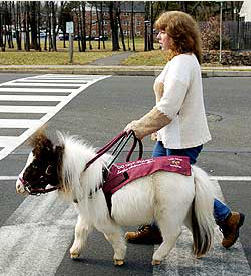 The correct Master position.
Die korrekte Master Position.
|
- The Heel-command then is NOT an obedient staying by the handler’s side, but rather implies taking the initiative! When I play with Beau, this seems to be VERY difficult for him – as cheeky as he can be in other situations, he is very tentative when asked to lead ME.
|
|
- Das „Bei Fuß!“ ist daher nicht ein braves Folgen an der Seite des Geführten, sondern bedingt das Ergreifen von Initiative! Wenn ich mit Beau spiele, scheint das für ihn SEHR schwierig zu sein – so forsch er in anderen Situationen sein kann, ist er sehr zögerlich, wenn er mich führen soll.
|
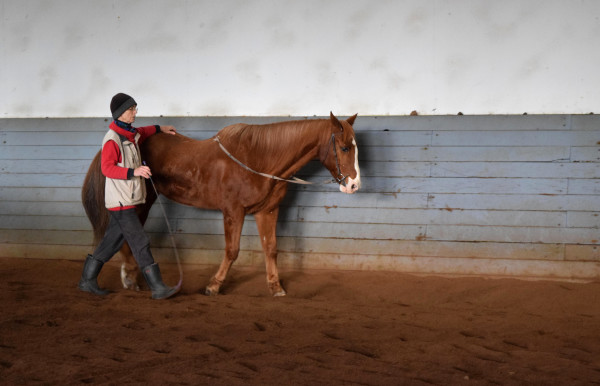 Beau’s questioning ears show that he is not at all sure about this leading business… he is very tentative!
Beaus fragende Ohren zeigen, daß er sich in der Führposition gar nicht so sicher fühlt, er ist sehr zögerlich! |
A guide animal goes with the pedestrian flow:
- if the guide started to angle away from the straight line, a blind handler might lose his orientation. More about this under command # 5.
- If a correction is needed, it is always given on the leash, or reins or rope, never on the harness!
- We have learned from the previous Blogs that the best way for ANY training is the “stimulation – response – reinforcement” way. This shows us how the horse perceives the cue, to which he responds by a trial and error guess– and we as trainers them tell him instantly, whether he guessed correctly or not by giving the reinforcement or ignoring his response.
And for all commands this is applicable:
- If the handler makes a mistake, he keeps his animal straight with his leg, drops the harness and praises his guide. Stop, think, then try again.
3) “Stand!” [our “stay!”]
- A guide animal has to stay by his handler’s side and often must wait extended times, while the blind person goes about his business.
- Especially when training a young animal, this can represent problems. And I certainly know enough people, whose horse’s fidget and paw constantly when being groomed in the cross-ties. This is mostly an expression of boredom, but of course also of a lack of manners – a lack of the owner’s authority. On page 40, Game # 2 in my book “From Leading to Liberty” I show how you can eliminate those problems by teaching your horse the “Parking Game”. I quote: “In the herd, the lead-mare tells the other horses when to move, where to go, in which direction and at what speed. “As it is our main goal in natural horsemanship to become our partner’s lead-mare, precisely to HAVE this kind of authority, we do all this in the parking game: we teach him to wait for OUR command to move, destination at the moment is right here, direction at the moment is nowhere, and speed is zero. Simple! “Stay!” therefore means, “remain right here until I release you”.
|
|
Ein Führtier läuft mit dem Fluß des Fußgänger-verkehrs mit:
- wenn es von der Geraden abbiegt, könnte der Blinde seine Orientierung verlieren. Darüber mehr im Kommando Nr. 5.
- Wenn eine Korrektur notwendig wird, wird sie immer am Seil oder Zügel gegeben, niemals am Geschirr!
- Wir haben in den früheren Blogs gelernt, daß die beste Weise für JEDES Training die Abfolge: „Anreiz – Reaktion – Bestärkung“ ist. Das zeigt uns, wie das Pferd den Anreiz (das Kommando) versteht, auf welches es mit der Probiermethode eine Lösung sucht – und der Ausbilder sagt ihm sofort mit seiner Bestärkung (oder Ignorieren seines Versuchs), ob er richtig geraten hat.
Und für alle Kommandos gilt:
- Wenn der Ausbilder einen Fehler macht, hält er das Führtier mit seinem Bein gerade, läßt den Griff fallen und lobt seinen Führer. Stopp, nachdenken, nochmal versuchen.
3) “Steh!” [unser “stay!”]
- Ein Führtier muß an der Seite seines Betreuers bleiben und oft längere Zeitspannen warten, während der Blinde seine Geschäfte erledigt.
- Besonders wenn man ein junges Tier ausbildet, kann das ein Problem sein. Und ich kenne genug Leute, deren Pferde zappeln und dauernd scharren, wenn sie zum Putzen auf der Stallgasse angebunden sind. Das ist hautsächlich ein Ausdruck von Langeweile, aber natürlich auch ein Mangel an guten Manieren – ein Mangel an Autorität des Besitzers. Auf Seite 40 im Spiel 2 des Buches “From Leading to Liberty” zeige ich, wie man dieses Problem loswerden kann, indem man das „Parking Game“ spielt. Ich zitiere: „In der Herde bestimmt die Leitstute, wann sich die anderen Pferde bewegen, wohin man geht, in welche Richtung und in welchem Tempo.“ Da unser Hauptziel im Natural Horsemanship ja ist, die Leitstute unseres Pferdes zu werden, und eben genau UM deren Autorität zu erlangen, üben wir all das im Parken-Spiel: wir lehren es auf UNSER Kommando zu warten, bis man sich bewegt, das Ziel ist momentan an dieser Stelle hier, die Richtung ist nirgendwohin und das Tempo ist Null. Einfach! „Stay!“ heißt daher: “bleib genau hier bis ich dich entlasse”.
|
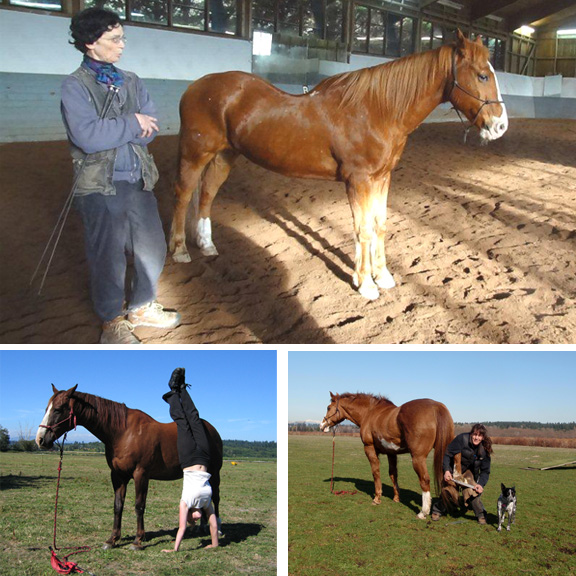 The Parking Game teaches the horse to stand still until released. The horses below are reliably parked!
Das Parken-Spiel lehrt das Pferd still zu stehen, bis es entlassen wird. Die Pferde unten sind verläßlich geparkt!
|
- Of course we train all this with positive reinforcement as usual, ignoring unwanted behavior as much as possible. You can use your clicker, if you wish (see also Alexandra Kurland: “Clicker Training For Your Horse” and the video lesson series “The Click That Teaches”). The important point is that you do not MAKE your horse stand still (one does not try to force one’s friends!), but to ASK him to do so and to reward him for willing cooperation. Horses LIKE to perform things that pay!!
- Blind or not – this is a most important exercise to teach, which is why it appears right at the beginning of my book with the 100 training games. The parking game is your first test of where you truly stand with regards to your authority over your horse. Without his honest respect for you, forget relying on him like a blind person to lead you through life!For guide dogs the “Stay!” command is used in connection with sitting or lying down, with guide minis just with the latter. They don’t have to sit!
|
|
- Wie immer üben wir all das mit positiver Bestärkung und ignorieren unerwünschte Reaktionen so gut es geht. Man kann den Klicker benutzen (siehe auch Alexandra Kurland: “Clicker Training For Your Horse” und die Video Serie “The Click That Teaches”). Wichtig ist, daß man sein Pferd nicht ZWINGT still zu stehen (man zwingt seine Freunde zu nichts), sondern es BITTET und dann für sein williges Mitmachen belohnt. Pferde leisten gerne Dinge, die sich auszahlen!
- Blind oder nicht – es ist eine überaus wichtige Lehraufgabe, weswegen sie ja auch gleich am Anfang des Buches vorkommt. Das Parkspiel ist der erste Test, wo Sie bezüglich Ihrer Autorität über Ihr Pferd wirklich stehen. Solange es keinen ehrlichen Respekt für Sie empfindet, kann man es vergessen, sich ihm wie ein Blinder mit seinem Leben anzuvertrauen!Für Blindenhunde wird das Kommando „Steh!“ oder „Bleib!“ auch im Zusammenhang mit Sitzen oder Ablegen benutzt, mit Minis nur mit dem letzteren. Sie müssen nicht sitzen!
|
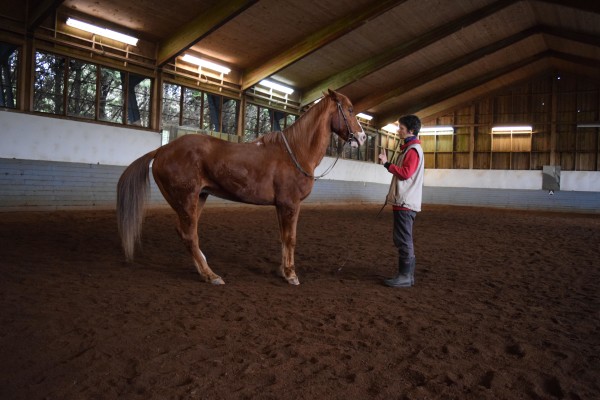 As eager as Beau is here, he knows to wait for the command!
So eifrig Beau hier auch ist, er weiß, daß er auf das Kommando warten muß. |
3a) The “Wait!” command:
- The wait-command with guide animals is mostly used for brief halts at a door or for teaching right-shoulder-work, i.e. situations where an obstacle is located at the right side of the handler. More about this later.
- In my training the wait command is similar to “Stay!”, but signifies to my horse that I’ll be back in a minute, for example when Beau stands free in the courtyard and I run back into the tack room to get what I forgot.
4) “Forward!” [our “walk on!]
- A guide pony must be able to take the initiative, BUT he never moves without directions from the handler, even in familiar places (exceptions are listed under point 16 “intelligent disobedience”).
- On the command “Forward!” (I use “Walk on!”) the guide sets himself in motion, after being lined up in the desired direction by his handler (the blind person does not start out first!!) Now he must walk without forging ahead or lagging behind, regardless of eventual distractions!
- I think that in terms of distractions one would see significant differences between training a guide dog or a guide horse: it lies in their nature! Where the dog might be distracted by running squirrels, which tickle his hunting instinct (dogs being predators), a horse would more likely be distracted by things he perceives as a threat, triggering his flight instinct (after all he is a prey animal).
- So making the horse courageous (see the Blog series “Playing – with knowledge!” Part 07 to 11) is of utmost importance for a guide horse.The guide now walks forward on cue, with the handler’s left hand on the harness (in my case on Beau’s spine) while her right hand holds the lead and points forward to initiate the movement – before the handler moves herself! (Game #1 in “From Leading to Liberty” shows the vocabulary of your body language to clarify your commands). The voice should be energetic and motivating and the handler could slap a whip against her leg to egg him on.
|
|
3a) “Warte!”:
- Das “Warte!” Kommando wird mit Führtieren hauptsächlich bei kurzem Halten an einer Tür oder bei der Rechts-Schulter-Ausbildung benutzt, d.h. wenn sich ein Hindernis rechts vom Geführten befindet. Mehr darüber später.
- In meinem Training ist dieser Befehl dem des „Stay!“ ahnlich, aber es bedeutet meinem Pferd, daß ich gleich zurück kommen werde, zum Beispiel, wenn Beau frei im Hof wartet und ich schnell noch etwas aus der Sattelkammer holen muß.
4) „Vorwärts!“ [unser “walk on!]
- Ein Führpony muß die Initiative ergreifen können, aber es setzt sich nie ohne Anleitung des Blinden in Bewegung, nicht einmal in vertrauter Umgebung (Ausnahmen stehen unter Punkt 16 „intelligenter Ungehorsam“)
- Auf das Kommando „Vorwärts!“ (ich benutze „Walk-on!“) setzt sich das Führtier in Bewegung, nachdem der Besitzer es in die erwünschte Richtung ausgerichtet hat (der Blinde läuft nicht als Erster los!!) Nun muß es gehen ohne zu eilen oder zu trödeln, ganz unabhängig vom eventueller Ablenkung!
- Beim Thema Ablenkung denke ich müßte man gravierende Unterschiede zwischen dem Training von Blindenhunden und Blindenponys sehen: das liegt in ihrer Natur! Wo der Jagdinstinkt eines Hundes z.B. von einem davonrennenden Eichhörnchen gekitzelt wird (Hunde sind ja Raubtiere), würde ein Pony eher von Dingen abgelenkt, die es als Drohung empfindet und die daher seinen Fluchtinstinkt auslösen (es ist ja ein Beutetier).
- Das Pferd mutiger zu machen (siehe die Blog Serie “Playing – with knowledge!” [fachmännisch spielen], Teil 07 bis 11) ist daher für ein Führpony enorm wichtig.Das Führpony geht nun auf Befehl voran, die linke Hand des Ausbilders liegt auf dem Geschirr (in meinem Fall auf Beaus Wirbelsäule), während seine rechte Hand das Seil hält und nach vorn zeigt, um die Bewegung einzuleiten – bevor er sich selbst in Bewegung setzt! (Spiel #1 in “From Leading to Liberty” zeigt das Vokabular Ihrer Körpersprache um Ihre Kommandos zu verdeutlichen). Die Stimme sollte energisch und motivierend sein und der Ausbilder könnte als weiteren Anreiz seine Gerte gegen sein Bein klatschen.
|
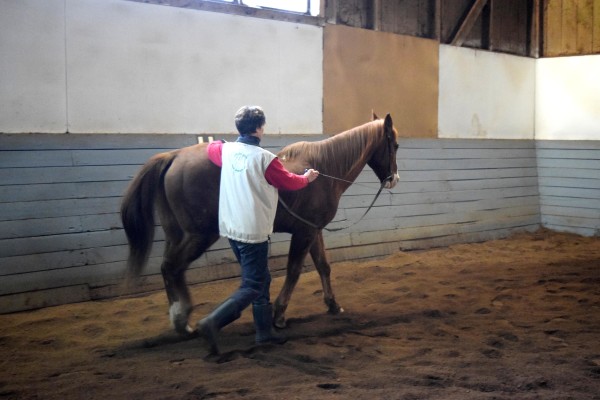 Forward! The initiative must come from the horse. The whip helps pointing him in the intended direction.
Vorwärts! Die Initiative muß vom Pferd ausgehen. Die Gerte zeigt helfend in die erwünschte Richtung. |
- NEVER pull on the leash to get him going! You remember in any case and any situation we do NOT pull on our horses….
- For a guide animal it is very important to be able to stay on a predictable line of travel. This is usually the left side of a road without a sidewalk, otherwise in the right centre of the walk and along the building walls. This is very important for the blind person’s sense of orientation, as s/he is following a previously planned trip in the mind.
In the next Blog we talk about how to achieve a predictable line of travel, starting with the command # 5) “no! straight!”
Read on !!!
|
|
- Man zieht NIE am Seil, um es zum Gehen anzuregen! Sie wissen ja schon, daß wir überhaupt nie an unseren Pferden ziehen…
- Für ein Führtier ist es sehr wichtig, daß es auf einer voraussehbaren Spur bleiben kann. Das ist üblicherweise die linke Straßenseite, wenn es keinen Gehweg gibt, oder die rechte Mitte des Bürgersteigs und entlang der Mauern der Gebäude. Das ist für die Orientierung eines Blinden sehr wichtig, da er/sie ja einer vorher geplanten Route folgen will.
Im nächsten Blog geht es um das Verfolgen einer geplanten Route mit dem Kommando # 5) “nein! Gradaus!”
Lesen Sie weiter !!!
|






